Last Updated on July 24, 2024 by Vinson Lozano
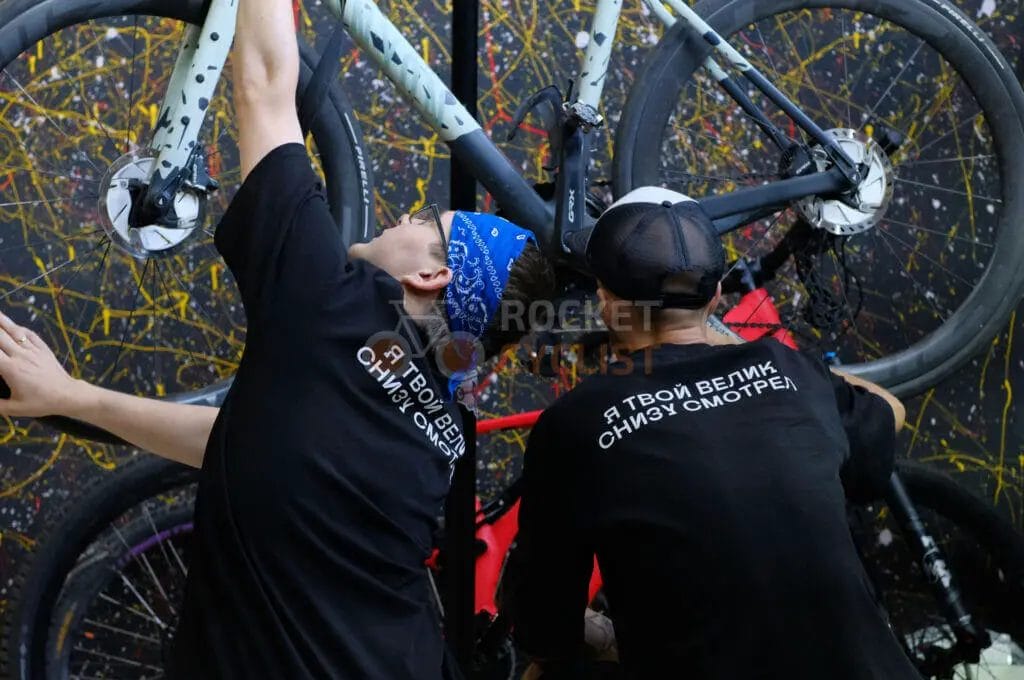
Have you been considering upgrading your gravel bike’s components but can’t decide which Shimano GRX groupset to choose? Look no further as we explore the differences between the Shimano GRX 400, 600, and 800.
These groupsets cater to a wide range of adventure riders, bikepackers, and cyclocross racers with varying gear ratios, drivetrain options, and price points. So, let’s compare all the available GRX variants ,and find out which Shimano GRX groupset is the best fit for your needs.
What is Shimano GRX?
Shimano GRX is a bicycle groupset specifically designed for gravel and adventure riders, bikepackers, and cyclocross racers, offering a wide array of possible builds, including 10-speed, 11-speed, and 12-speed setups. Specific GRX groupset is also available in mechanical and electronic variants.
Shimano GRX groupset is also available in 1x and 2x drivetrains setup, so gravel riders can choose simplicity with 1x setup or 2x configuration, if they wanted to have wide range gear selections for their gravel adventures.
GRX 400, 600, and 800 – Key Differences & Comparisons
GRX 400
- Equivalent to 10-speed Tiagra groupset
- Mix and match with GRX 600 crank
- 10-speed
- Mechanical shifting only
GRX 600
- Equivalent to 10 or 11-speed Shimano 105 groupset.
- Mix and match with GRX 400 or 800 series rear derailluer.
- Available in 11, and 12 -speed configurations.
- Has 10-speed front chain to support GRX 400
- Mechanical shifting only
GRX 800
- Equivalent to 11 or 12-speed Shimano Ultegra groupset.
- Hollowtech crank
- Shadow RD
- Mechanical and electronic shifting (Di2)
It’s important to compare the Shimano GRX 400, 600, and 800 groupsets, because each offer unique features and benefits that may suit different riding styles and preferences.
By understanding the differences between these groupsets, riders can make an informed decision when choosing the best component set for their needs.
For example, the GRX 800 uses Shimano’s Hollowtech II hollow crank arm technology, while the GRX 600 does not. Yes, that is right and we have confirmed this on the Shimano website.
Additionally, the GRX 800 and 600 offer different ranges of gear ratios and teeth sizes in their chainsets, which may be crucial for riders who require specific gearing for their terrain.
In fact, Shimano just released a 12-speed version of their GRX 800 series (GRX RX820) last month, which is available in 1x and 2x configurations. This new gravel-specific groupset is said to offer more gearing range because of the 2 added gears, smoother shifting, reliable braking, and more aggressive hoods design for more comfortable and secure riding.
Shimano GRX 400
The Shimano GRX 400 is a component series designed for gravel and adventure riders, providing a wide range of possible builds including 10-speed and 11-speed setups, 1x and 2x drivetrains.
It is comparable to Shimano’s Tiagra level and is only available in a mechanical version. The chainsets in this series use Shimano’s Dynamic Chain Engagement tooth profile, which prevents the chain from bouncing off on rough terrain.
The chainline of the 400 series has been shifted outwards by 2.5mm compared to existing road components, providing increased tire and frame clearance.
One drawback of using GRX 400 is that it lacks certain components in the range, meaning you may need to mix and match with components from other ranges. For example, there is no GRX400 crank, so you will need to use a GRX 600 crank or compatible crankset from other manufacturers such as Prowheel RPL 170*46/34 Hollowtech, Weapon GR 350 40/36T, etc.
Overall, the GRX 400 is a suitable option for those on a budget, but still wanted to have a solid gravel-specific groupset.
Equivalents to other Shimano groupsets
When comes to comparing the Shimano GRX 400, 600, and 800, it’s helpful to understand how they stack up against other Shimano groupsets.
The GRX 800 is equivalent to Ultegra in a mechanical version.
Meanwhile, the GRX 600 is equivalent to the 105 2×11 or 1×11 drivetrain, and the GRX 400 is similar to the 10-speed Tiagra groupset. It’s important to note that not all components are available in every level of the GRX range, so there may be some mixing and matching required.
Despite this, all GRX components offer great performance and useful gearing for gravel and adventure riders, bikepackers, and cyclocross racers. With hydraulic disc brakes and a wide range of cassette and chain options, the Shimano GRX groupset is a versatile and reliable choice for any gravel enthusiast.
Features unique to GRX 400
The GRX 400 is a component series designed for gravel and adventure riders who want a reliable and versatile groupset. What sets it apart from other Shimano groupsets is its unique features that cater to the needs of off-road cycling.
One of its notable features is its 10-speed drivetrain, which provides a wide range of gearing options for climbing and descending on variable terrains.
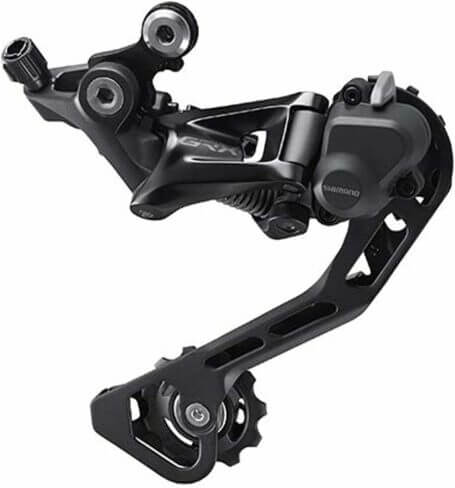
It also has a wide-range or close-range gears that allows you to choose the gear that best suits your riding style. Moreover, the GRX 400 is equipped with a clutch rear derailleur that helps keep the chain tight and prevents chain slap, making for a quieter and smoother ride.
Its unique chainline also enhances frame clearance and tire compatibility, allowing riders to use wider tyres for improved traction and comfort. Overall, the Shimano GRX 400 is a strong and reliable groupset that offers unique features ideal for gravel and adventure riding.
Pros and cons of using GRX 400
The Shimano GRX 400 is a great choice for those looking for a dependable and affordable gravel groupset. Its outstanding performance across the range makes it a reliable choice for most riders.
The fact that it is compatible with other Shimano groupset components also makes it easy to source parts when needed. Overall, the GRX 400 is a solid choice for those looking for a reliable and functional gravel groupset without breaking the bank.
Shimano GRX 600
The Shimano GRX 600 is equivalent to the 105 2×11 or 1×11 drivetrain, making it a mid-range groupset with a full selection of gears suitable for all kinds of adventures.
It offers smooth and quiet gear shifts, and the derailleur chain retention is highly effective on rough terrain. The chainset is available in 2x with 46/30-tooth chainrings and 1x with a 40-tooth chainring, and has a chainline shifted outwards by 2.5mm compared to existing road components, allowing for increased tire and frame clearance.
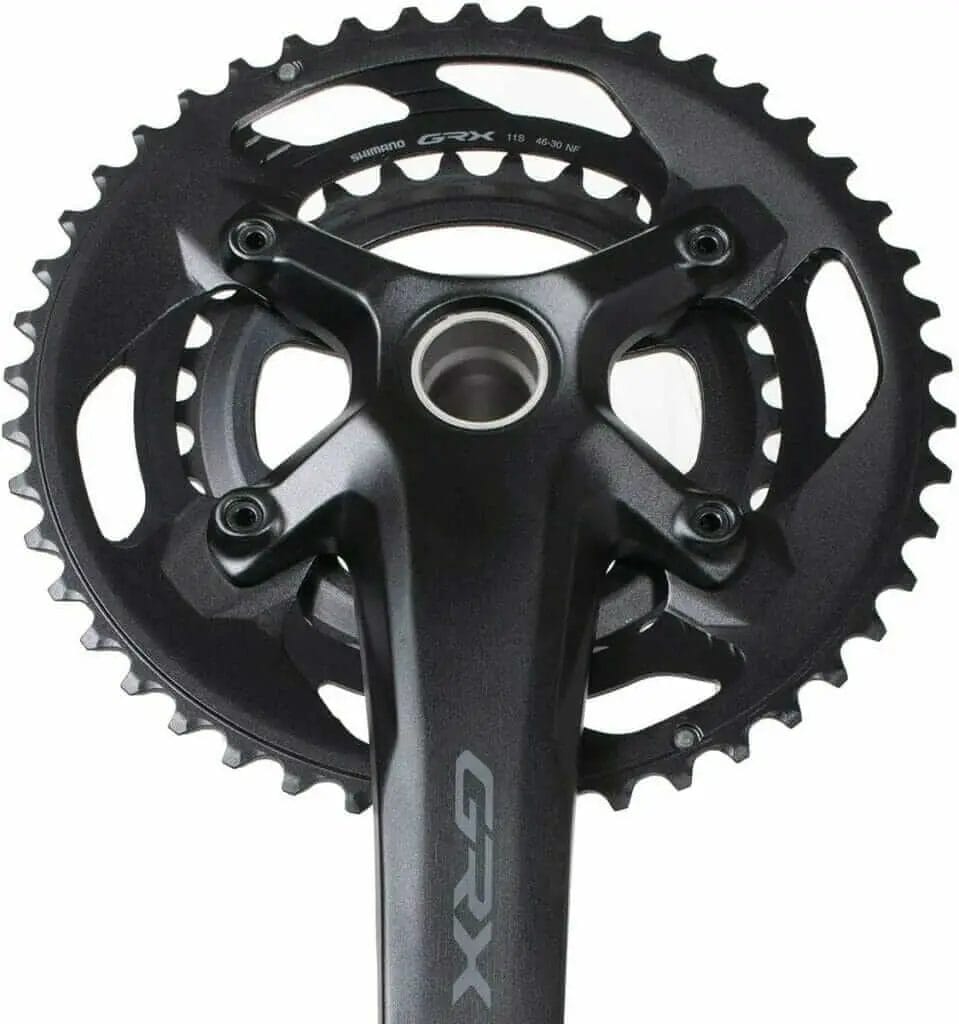
The crankset does not use Shimano’s Hollowtech technology, which is reserved for the GRX 800 series and makes the latter 100 grams lighter. Despite this, the GRX 600 is a solid choice for those seeking a reliable and versatile gravel groupset at a reasonable price point.
Most GRX 400 users’ upgrade path is the GRX 600 crank to complete their GRX gravel setup.
Equivalents to other Shimano groupsets
When it comes to Shimano GRX, it can be helpful to understand how it compares to other Shimano groupsets.
The RX800 level is equivalent to Ultegra in a mechanical version and Di2 2×11 or 1×11 drivetrain, while the RX600 level is similar to the 105 2×11 or 1×11 drivetrain.
The RX400 level is comparable to the 10-speed Tiagra groupset. However, it’s important to note that you can’t have a complete RX600 groupset since there’s no RX600 rear derailleur.
Instead, you may need to mix and match components to achieve the desired setup. GRX also includes features unique to the gravel riding experience, such as a wider chainline and the inclusion of a clutch in the derailleur to prevent chain drop on rough.
When the Shimano GRX 400, 600, and 800, it’s important to understand their equivalents to other Shimano groupsets. The RX800, for instance, is equivalent to Ultegra in a mechanical version and Di2 2×11 or 1×11 drivetrain, while the RX600 is equivalent to the 105 2×11 or 1×11 drivetrain.
These similarities can help when deciding which Shimano groupset is best for your gravel or adventure bike. Each groupset offers unique features and benefits, so understanding the differences between them can help you make the best decision for your needs.
Features unique to GRX 600
One of the unique features of the Shimano GRX 600 is the shifters, specifically the left-hand shifter. Not only does it control the front derailleur, but it can also operate an adjustable seat post.
This allows for a cleaner cockpit and eliminates the need for an additional lever.
Additionally, the chainset options for the GRX 600 include both 2×11-speed and 1×11-speed, allowing for flexibility in gearing options.
The chainline on the crank is shifted outwards by 2.5mm, providing increased frame and tire clearance for wider tires commonly used in gravel riding.
Similar to the other GRX groupsets, the GRX 600 also features hydraulic disc brakes for reliable stopping power in all weather conditions. Overall, the GRX 600 offers a mid-range option for gravel riders looking for a versatile and reliable groupset.
Pros and cons of using GRX 600
One the pros of using the Shimano GRX 600 groupset is its outstanding performance across the range, making for excellent shifting and braking.
The gearing options available also suit most riders, offering versatility in comparison to other 1x groupsets. However, a downside to the GRX 600 is that it lacks its own derailleurs or brake calipers, making it a mix-and-match situation when it comes to comparing it with other Shimano groupsets.
Overall, the GRX 600 may be a mid-range groupset, but it offers dependable performance at an excellent value for money. However, those looking for higher-end features, such as free-stroke adjustment or dropper post compatibility, may want to consider the 800-series levers instead.
Shimano GRX 800
GRX 800 is the top-of-the-line gravel groupset from Shimano that is equivalent to Ultegra in a mechanical version and Di2 2×11 or 1×11 drivetrain.
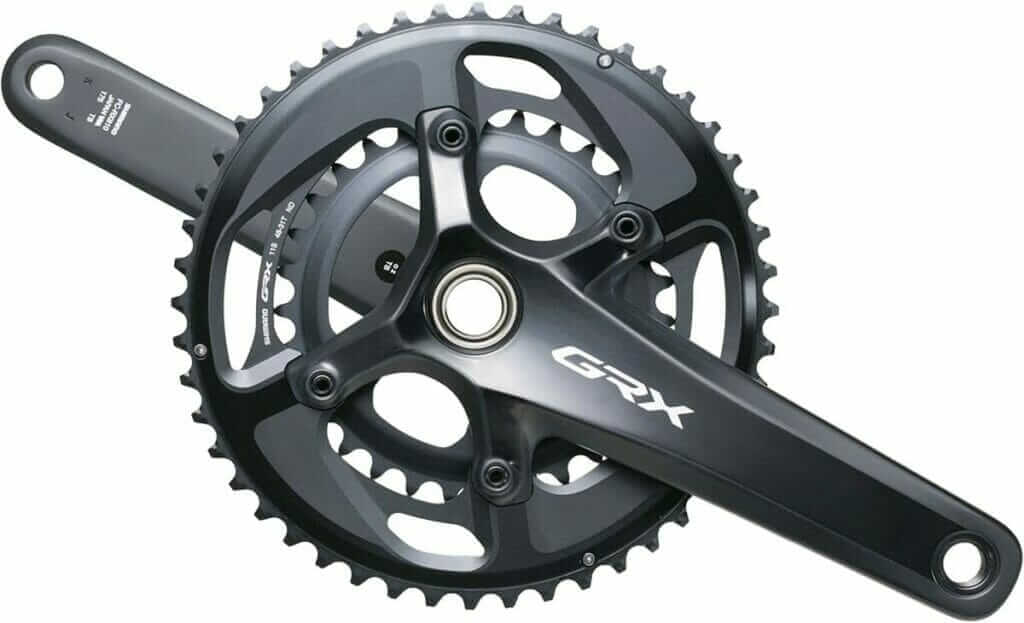
The crankset on the GRX 800 uses Shimano’s Hollowtech technology that makes it 100 grams lighter than the GRX 600.
The GRX 800 also has a longer derailleur cage, which offers a standard range of 11-42t. The shifters of the GRX 800 have technology from MTB brakes that offer even less force required for braking and more accurate brake modulation.
GRX 800 rear derailleurs use Shimanos Shadow RD+ technology, stabilizing the chain on rough terrain by minimizing unnecessary derailleur arm movement.

Additionally, the GRX 800 rear derailleur further sits underneath the cassette than traditional road derailleurs and doesn’t extend far out when using the small sprockets, making it less exposed and vulnerable to damage by things like undergrowth and rocks.
Equivalents to other Shimano groupsets
Shimano GRX groupset is designed exclusively for gravel and adventure riders, bike-packers, and cyclocross racers. It combines the key technologies and components from Shimano’s current road and mountain bike groupsets, making it a unique option.
The Shimano GRX series is divided into three different levels: RX800 equivalent to Ultegra in a mechanical version and Di2 2×11 or 1×11 drivetrain, RX600 equivalent to 105 2×11 or 1×11 drivetrain, and RX400 equivalent to Tiagra 2×10 drivetrain.
Despite being similar to Shimano’s current road and mountain bike groupsets, GRX features key differences, such as wider 2.5mm chainline, clutch mechanisms, raised axles of the brake lever, and the ability to accommodate wider tires up to 42mm. GRX also offers several equivalents to other Shimano groupsets, making it a versatile option for any type of rider.
Features unique to GRX 800
Theano GRX 800 groupset is the ideal choice for riders who are looking for top-of-the-line features for their gravel bike.
One of the key features of the GRX 800 is its use of Shimano’s Hollowtech technology in the crankset, making it significantly lighter than the GRX 600.
This groupset also offers a rear derailleur with a long cage and a standard range of 11-42t. The brake levers in the GRX 800 also feature MTB brake technology, making braking even more precise and less force-intensive.
Additionally, this groupset includes an adjustable seatpost operated by the left-hand shifter, allowing riders to declutter their cockpit and give their bike a sleeker look. The use of Shadow RD+ technology ensures a smooth and quiet ride with exceptional shifting performance. Overall, the GRX 800 has all the features needed for a high-performance gravel bike.
Pros and cons of using GRX 800
The GRX 800 groupset is Shimano’s top-tier offering for gravel bikes, with Di2 electronic shifting and hydraulic disc brakes. One major advantage of using the GRX 800 is its excellent performance and precise shifting.
The integration of electronic shifting and hydraulic disc brakes makes this groupset ideal for all conditions, especially for those who want the most performance possible.
The GRX 800 features slightly larger chainrings which also means a slightly higher gear ratio. While some riders may appreciate this added power, others may find it a bit too much for their needs.
Another con of using the GRX 800 is its price point, as it is the most expensive offering from Shimano. However, if you are looking for the ultimate performance and unparalleled functionality, the GRX 800 may be the perfect choice for you.
Shimano GRX 820
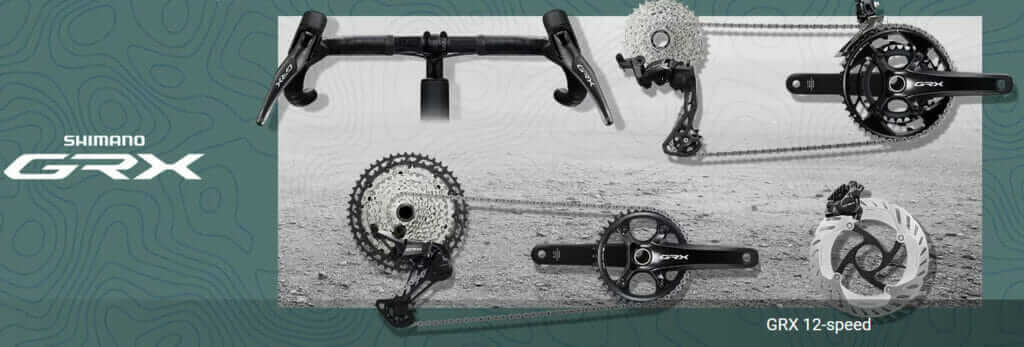
Introducing Shimano’s latest innovation designed specifically for gravel riding enthusiasts – the GRX 820 groupset! With its superior performance and rugged durability, this groupset takes your gravel adventures to new heights. Packed with advanced features and engineering, it ensures a smooth and reliable experience on any terrain. Let’s dive into the specifications, variants, and pricing of this exceptional groupset:
Specifications:
- Compatibility: 11-speed drivetrain
- Crankset: Available in 1x, 2x configurations
- Cassette: Wide range options for tackling all gradients
- Front derailleur: Improved design for precise shifting
- Rear derailleur: Optimized for gravel-specific needs
- Brake system: Hydraulic disc brakes with ergonomic levers
- Shifters: Ergonomic hoods for comfortable handling
- Chain: Enhanced for durability and reliability
- Bottom bracket: Various options to fit your frame needs
- Weight: Lightweight construction for optimal performance
- Groupset variants: GRX 820 1x and GRX 820 2x configurations
Improvements:
- Enhanced Gear Range: The GRX 820 groupset offers a wider range of gears, enabling you to conquer varying terrains effortlessly.
- Improved Shifting: Upgraded front and rear derailleurs provide precise and reliable shifting even under demanding gravel conditions.
- Hydraulic Disc Brakes: The hydraulic disc brake system ensures powerful, yet controlled braking on challenging surfaces for enhanced confidence and safety.
- Ergonomic Design: The shifters and brake levers feature ergonomic hoods, providing a comfortable grip and reducing hand fatigue during long rides.
- Unmatched Durability: With a focus on ruggedness, the GRX 820 groupset is built to withstand the demands of off-road riding while maintaining long-lasting performance.
- Customizable Bottom Bracket: Shimano offers various bottom bracket options, allowing you to seamlessly fit the groupset to your specific frame requirements.
Pricing:
- 1x Crankset – $249.99
- 2x Crankset – $249.99
- Rear Derailleur – $126.99
- Front Derailleur – $61.99
- Shifter/Brake Levers w/ Brake Caliper
- Right side/rear shifter – $444.99
- Left side/dropper remote – $414.99
- Left side/brake only – $384.99
- Left side/front shifter – $441.99
- Cassette
- 10-45 XT – $164.99
- 10-51 XT – $164.99
- 11-36 105 – $87.99
- Chain – $48.99
- 160mm ICE Tech Freeza Rotor – $121.98
Whether you’re tackling gravel roads, exploring the wilderness, or going on epic bikepacking adventures, the Shimano GRX 820 groupset is the ultimate companion. It combines reliability, versatility, and performance to elevate your gravel riding experience to new heights. Upgrade your gravel rig with the GRX 820 groupset and unlock a world of possibilities on two wheels!
Why Choose 1x Gravel Groupset?
When it comes to optimizing performance and simplifying the riding experience, the 1x (pronounced “one-by”) gravel groupset stands at the forefront of contemporary cycling technology. A 1x groupset offers a single chainring at the front with a wide-range cassette at the rear, eliminating the need for a front derailleur. This setup provides a multitude of benefits, catering to the modern gravel cyclist’s needs. Notably, a 1x system trims weight — an important factor in a discipline where every gram matters. Without a front derailleur and second chainring, the bike becomes lighter, translating into more efficient power transfer when navigating challenging terrain.
Moreover, the latest data accentuate the 1x’s superior chain retention due to the narrow-wide tooth pattern on the chainring, which grips the chain steadfastly across bumpy landscapes. This design innovation diminishes the likelihood of chain drops, a frequent nuisance on rugged courses, assuring a smoother, interruption-free ride. Simplicity is another key advantage. The 1x groupset consolidates gearing choices to a single shifter, streamlining decision-making and allowing the rider to focus more on the trail ahead instead of on gear selection. This straightforwardness is not only a boon for beginner riders but also for veterans who prefer a minimalist cockpit.
Maintenance becomes less of a chore with fewer moving parts to manage, which is particularly advantageous given the typical gravel riding conditions that can increase wear and tear on a bike’s components. The 1x setup’s durability and the reduced need for adjustments over time play a significant role in its rising popularity among gravel enthusiasts.
Lastly, with the continuous advances in drivetrain technology, the range of 1x cassettes has extended, closing the gap to the gear range offered by traditional double chainring systems. For instance, the latest SRAM and Shimano 1x groupsets offer up to a 10-52 tooth range, ensuring that both climbing and speed on the flats are amply catered for. This expansion in gear range ensures that the 1x system can stand toe-to-toe with its 2x counterparts, empowering riders to tackle a vast array of gradients without the penalty of additional complexity.
In conclusion, the 1x gravel groupset is an emblem of efficiency, resilience, and streamlined operation, perfectly tailored for the demands of modern gravel riding. Its combination of weight savings, enhanced chain security, and maintenance ease, coupled with an evolving gear range that meets diverse riding needs, positions the 1x system as an optimal choice for both competitive and recreational gravel cyclists.
Why Choose 2x Gravel Groupset?
The 2x gravel groupset, with its dual chainring setup at the crank, remains a compelling choice for many gravel riders, offering distinct advantages in versatility and gear range. Let’s dissect why a 2x system could be the preferred gearing for your gravel adventures. The fundamental draw of a 2x groupset is its wide and nuanced gear selection. With two chainrings up front and typically an 11 or 12-speed cassette at the rear, riders have access to a broader spectrum of gears that can be fine-tuned for any gradient or pace. This breadth of choice ensures that whether you’re spinning up a steep incline or pushing speed on flat terrains, an optimal gear is always at your disposal.
Key to its appeal is the 2x groupset’s smaller jumps between gears, providing a smoother pedaling experience. Riders can maintain a consistent cadence, which is crucial for efficiency and endurance, especially over long distances where muscle fatigue can accumulate. In 2024, major players in the industry like Shimano and SRAM are continuously refining their 2x offerings, with cassettes that provide close spacing for the most-used middle gears and wider spacing at the high and low end, ensuring top performance in diverse conditions.
Additionally, a 2x groupset delivers superior mechanical advantage. By allowing the chain to run straighter across a wider gear range, there’s a decrease in friction compared to the extreme angles sometimes seen in a 1x setup with a very wide rear cassette. This translates to less wear on the drivetrain and greater overall efficiency. Durability is particularly important in the often-grueling conditions of gravel riding, where reliability can be the difference between a successful ride and a mechanical failure miles from help.
Moreover, some riders prefer the familiar feel and function of 2x systems, especially those transitioning from road cycling who may favor the incremental control and traditional operation. Despite the added complexity of a front derailleur, the latest data indicate that with advancements in shifter ergonomics and derailleur design, the added maintenance is becoming less of an issue.
In sum, the 2x gravel groupset offers a combination of fine-tuned gear options, efficient power transfer, and the comfort of familiar ergonomics for many riders. It’s the system that keeps you in the right gear, with just the right amount of effort, across the unpredictable canvas of gravel riding. While 1x systems gain traction for their simplicity and weight benefits, the 2x holds its ground as a versatile, efficient, and reliable companion for riders aiming to tackle a full spectrum of terrains and gradients.
Compatibility with Other Groupset Components
Compatibility with Shimano Road Groupsets
Shimano GRX components are designed to be compatible with Shimano’s road groupsets. For example, GRX rear derailleurs can work with Shimano’s road shifters, making it easier to mix and match components.
Compatibility with SRAM and Campagnolo
While Shimano GRX is primarily designed to work within its ecosystem, some components can be compatible with SRAM and Campagnolo. However, it’s essential to check specific compatibility charts and guidelines to avoid any issues.
Popular Gravel Bikes with GRX Groupsets
1. Canyon Grail CF SLX 8 Di2
- Specifications:
- Frame: Carbon
- Fork: Carbon
- Groupset: Shimano GRX Di2
- Wheels: DT Swiss GRC1400 Spline carbon wheels
- Tyres: 42mm clearance
- Weight: 8.2 kg
- Available Colors: Various
- Pricing: £4,799 / 4,999/€5,099/𝐴𝑈4,999/€5,099/AU7,649
2. Canyon Grizl
- Specifications:
- Frame: Carbon
- Fork: Carbon
- Groupset: Shimano GRX
- Wheels: DT Swiss
- Tyres: 50mm clearance
- Weight: 9.1 kg
- Available Colors: Various
- Pricing: £2,949 / 2,849/€2,699/𝐴𝑈2,849/€2,699/AU4,249
3. Orbea Terra M21e Team 1X
- Specifications:
- Frame: Carbon
- Fork: Carbon
- Groupset: Shimano GRX
- Wheels: Alloy
- Tyres: 40mm clearance
- Weight: 8.5 kg
- Available Colors: Various
- Pricing: £5,358 / $5,874 / €5,364
4. Ribble CGR 725 Steel
- Specifications:
- Frame: Reynolds 725 steel
- Fork: Carbon
- Groupset: Shimano GRX
- Wheels: Mavic Allroad
- Tyres: 47mm clearance
- Weight: 11 kg
- Available Colors: Various
- Pricing: £1,199 / 1,257/𝐴𝑈1,257/AU1,965
5. Bianchi Arcadex GRX 600
- Specifications:
- Frame: Carbon
- Fork: Carbon
- Groupset: Shimano GRX 600
- Wheels: Fulcrum Rapid Red 900
- Tyres: WTB Riddler 700x45c
- Weight: 9.8 kg
- Available Colors: Various
- Pricing: £3,499 / $4,737 / €4,000
6. Bianchi Impulso GRX 800 12s
- Specifications:
- Frame: Carbon
- Fork: Carbon
- Groupset: Shimano GRX 800 12s
- Wheels: Fulcrum Rapid Red 500
- Tyres: WTB Riddler 700x45c
- Weight: 9.5 kg
- Available Colors: Various
- Pricing: £4,737 / $5,000 / €4,500
7. Trek Checkpoint SL 7
- Specifications:
- Frame: 500 Series OCLV Carbon
- Fork: Checkpoint Carbon
- Groupset: Shimano GRX 2x
- Wheels: WTB ST i23 TCS
- Tyres: Vittoria Terreno Dry 700x38c
- Weight: 9.2 kg
- Available Colors: Various
- Pricing: $5,999.99
8. J Laverack GRiT
- Specifications:
- Frame: Titanium
- Fork: Carbon
- Groupset: Shimano GRX
- Wheels: Aera GR38 carbon wheelset
- Tyres: 650b×50mm or 700c×48mm
- Weight: 8.91 kg
- Available Colors: Various
- Pricing: £6,325
9. Pearson Off Grid
- Specifications:
- Frame: Carbon
- Fork: Carbon
- Groupset: Shimano GRX
- Wheels: Pearson Hoopdriver Bump and Grind carbon wheels
- Tyres: 700c tyres up to 42mm wide and 650b tyres up to 55mm
- Weight: 9.28 kg
- Available Colors: Matt orange and matt deep blue, and matt olive and matt black
- Pricing: £2,900 to £5,000
10. Kona Libre
- Specifications:
- Frame: Kona 6061 Aluminum Butted
- Fork: Kona Libre Carbon fork
- Groupset: Shimano GRX
- Wheels: WTB ST i23 TCS 2.0
- Tyres: Maxxis Rambler Silkshield TR 700x45c
- Weight: 10.5 kg
- Available Colors: Gloss Metallic Green w/ Matte Black Forest & Indicator Yellow Decals
- Pricing: $1,799
11. Giant Revolt Advanced
- Specifications:
- Frame: Advanced-grade composite
- Fork: Advanced-grade composite
- Groupset: Shimano GRX Di2
- Wheels: Giant CXR 1
- Tyres: Maxxis Receptor 40mm
- Weight: 8.27 kg
- Available Colors: Golden Haze, Panther
- Pricing: $3,000
12. Salsa Warbird Carbon GRX 810
- Specifications:
- Frame: Carbon
- Fork: Carbon
- Groupset: Shimano GRX 810
- Wheels: DT Swiss C 1800 Spline 23
- Tyres: Teravail Cannonball 700c x 42mm
- Weight: 9.3 kg
- Available Colors: Various
- Pricing: $4,499
13. Bianchi Via Nirone 7
- Specifications:
- Frame: Aluminum
- Fork: Carbon
- Groupset: Shimano GRX 400
- Wheels: Reparto Corse
- Tyres: Vittoria Zaffiro 700x28c
- Weight: 10.2 kg
- Available Colors: Various
- Pricing: $1,254.22
14. Colnago G3-X
- Specifications:
- Frame: Carbon
- Fork: Carbon
- Groupset: Shimano GRX 820
- Wheels: Fulcrum Rapid Red 500
- Tyres: Pirelli Cinturato Gravel H 700x40c
- Weight: 9.5 kg
- Available Colors: Various
- Pricing: $4,500
15. Merida Silex 600
- Specifications:
- Frame: Aluminum
- Fork: Carbon
- Groupset: Shimano GRX 600
- Wheels: Merida Expert CX
- Tyres: Maxxis Rambler 700x38c
- Weight: 10.1 kg
- Available Colors: Various
- Pricing: $2,100
16. Wilier Jena
- Specifications:
- Frame: Carbon
- Fork: Carbon
- Groupset: Shimano GRX 800
- Wheels: Miche Graff
- Tyres: Vittoria Terreno Mix 700x38c
- Weight: 9.0 kg
- Available Colors: Various
- Pricing: $4,200
FAQs
1. What is the main difference between Shimano GRX 400, 600, and 800?
The main differences lie in the drivetrain options, materials used, and pricing. GRX 400 is entry-level, GRX 600 is mid-range, and GRX 800 is high-end.
2. Can I mix Shimano GRX components with other Shimano road components?
Yes, Shimano GRX components are designed to be compatible with Shimano’s road groupsets.
3. Is Shimano GRX compatible with SRAM and Campagnolo?
Some components may be compatible, but it’s essential to check specific compatibility charts and guidelines.
4. What is the price range for Shimano GRX groupsets?
The price ranges from around $500 for GRX 400 to 1,200 for GRX 800.
5. Which Shimano GRX groupset is best for beginners?
The Shimano GRX 400 is the best option for beginners due to its affordability and ease of use.
6. What are the benefits of using Shimano GRX groupsets for gravel biking?
Shimano GRX groupsets offer better control, stability, and comfort on rough terrains, making them ideal for gravel biking.
7. Are there electronic shifting options available in Shimano GRX groupsets?
Yes, the GRX 800 series offers electronic shifting options (Di2).


